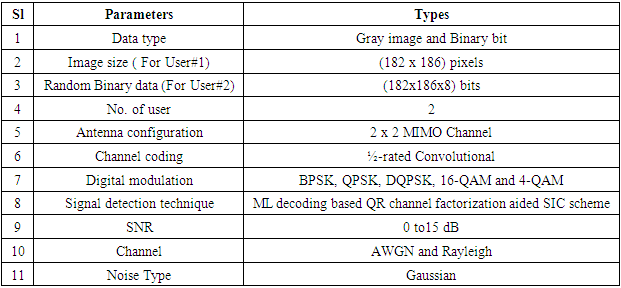-
Paper Information
- Paper Submission
-
Journal Information
- About This Journal
- Editorial Board
- Current Issue
- Archive
- Author Guidelines
- Contact Us
International Journal of Networks and Communications
p-ISSN: 2168-4936 e-ISSN: 2168-4944
2022; 12(1): 39-46
doi:10.5923/j.ijnc.20221201.03
Received: May 13, 2022; Accepted: Jun. 6, 2022; Published: Sep. 20, 2022

Performance Assessment of MIMO-NOMA System with Simultaneously Different Data Transmission for the Next Generation Wireless Communications
Md. Tofail Ahmed1, Md. Humaun Kabir2, Md. Imran Hossain3
1Department of Information and Communication Engineering, Pabna University of Science & Technology, Pabna, Bangladesh
2Department of Computer Science and Engineering, Bangamata Sheikh Fojilatunnesa Mujib Science & Technology University, Jamalpur, Bangladesh
3Department of Electrical, Electronic and Communication Engineering, Pabna University of Science & Technology, Pabna, Bangladesh
Correspondence to: Md. Humaun Kabir, Department of Computer Science and Engineering, Bangamata Sheikh Fojilatunnesa Mujib Science & Technology University, Jamalpur, Bangladesh.
| Email: |  |
Copyright © 2022 The Author(s). Published by Scientific & Academic Publishing.
This work is licensed under the Creative Commons Attribution International License (CC BY).
http://creativecommons.org/licenses/by/4.0/

In this paper, we have analyzed the performance of downlink multiuser six generation (6G) and beyond 5G (B5G) with concurrently different data transmission compatible MIMO-NOMA wireless communication system. The proposed simulated system has been implemented incorporating ML decoding based QR channel decomposition aided successive interference cancellation (SIC) scheme signal detection, convolutional channel coding, BPSK, and QAM digital modulation schemes. Two different types of messages are transmitted simultaneously from the base station (BS) through a 2×2 MIMO channel for two different users. The image data is transmitted for user one and synthetic data is used for the other user. By observing the simulation results, we can say that the system provides acceptable performance under AWGN and Rayleigh fading channels. To improve the performance, we have properly assigned power to the users, and accurately maintained the signal’s phase difference between the users. With the increase of the signal-to-noise ratio (SNR) the bit error rate (BER) has degraded adequately which indicates the system is very robust and efficient for the transmission of different data concurrently and suitable for the next generation of wireless communications.
Keywords: MIMO, NOMA, 5G, Beyond 5G, SIC, AWGN, BPSK, 4-QAM, 16-QAM, SNR, BER, MUD
Cite this paper: Md. Tofail Ahmed, Md. Humaun Kabir, Md. Imran Hossain, Performance Assessment of MIMO-NOMA System with Simultaneously Different Data Transmission for the Next Generation Wireless Communications, International Journal of Networks and Communications, Vol. 12 No. 1, 2022, pp. 39-46. doi: 10.5923/j.ijnc.20221201.03.
Article Outline
1. Introduction
- The rapid use of mobile communications has been increased last decade in both academic and industrial communities which motivates the research activities to design the next generation wireless networks that can introduce significant improvements in large coverage and user requirements [1]. It is an important role to determine the performance of mobile communication systems for next-generation wireless networks which utilize highly spectral-efficient multiple access techniques. Based on the way the resources are allocated to the users the multiple access techniques can be classified into orthogonal and non-orthogonal [2]. In the approach of Orthogonal Multiple Access (OMA) techniques, the users of each cell are assigned the resources exclusively and there is no interference between users, therefore, low-complexity detection approaches can be carried out in the receiver to recover the transmitted signals. The Long Term Evolution (LTE) and LTE-Advanced have been using in current mobile communication systems [3]. In LTE systems, OMA techniques such as Orthogonal Frequency Division Multiple Access (OFDMA) and Single Carrier Frequency Division Multiple Access (SC-FDMA) have been used. On the other hand, all the users can use whole allocated resources in Non-Orthogonal Multiple Access (NOMA) techniques simultaneously that’s why there has inter-user interference. Therefore, extra complex Multi-User Detection (MUD) techniques are required to retrieve the user’s transmitted signals at the receiver end. It is known that orthogonal multiple access transmission systems are appropriate for downlink to achieve the maximum number of users’ sum-rate [4]. Additionally, MUD techniques are more complex to implement at the user end for the inadequate processing power. OMA cannot attain the system upper bound for this reason it is not an ideal solution in terms of spectral efficiency to uplink [5]. When multiple users are considered in the MIMO-NOMA systems there will be a noticeable issue with inter-user interference cancellation [6]. Consequently, NOMA multiple access technique have the challenge to be implemented in the next generation of wireless networks to develop the maximum use of system spectral efficiency, The crucial advantage of NOMA is to share each resource element (in frequency or time domain) to all the users, and the power allocated to all users through iterative water-filling [7]. The number of users that share each subcarrier in the optimal NOMA scheme makes the MUD very complex at the receiver end. Therefore, other techniques that allow NOMA (such as Successive Interference Cancelation (SIC), Interleave Division Multiple Access (IDMA) [8], Low Density Spreading (LDS) [9], and Low Density Parity Check Code (LDPC) etc.) add redundancy via coding/spreading to help the users split-up at the receiver.
2. Literature Review
- Most common multiple access techniques such as Orthogonal Frequency Division Multiple Access (OFDMA) as well as other orthogonal multiple access techniques have a major issue to achieve the system capacity boundary in the uplink system according to the individuality in resource allocation. This issue is more familiar when fairness surrounding all users is considered in the multiple access system. NOMA technique can pointedly improve the system performance in terms of simultaneously accessing the multiple numbers of users, spectral efficiency, and fairness compared to OFDMA [10]. The new concept of Non-orthogonal Multiple Access (NOMA) has been recommended to increase multiple access of the total number of users than the number of available orthogonal time-domain, frequency-domain, or code-domain resources. The general concept of NOMA is to allow sharing of the non-orthogonal resource among the users at the ultimate cost of increased receiver complexity, which is a vital challenge for a researcher in separating the non-orthogonal signals. In recent times, several NOMA solutions have been investigated to solve the complex received data separation of all users [11]–[15], which can be divided into two main categories, one approach is power-domain NOMA [16] and another is code-domain NOMA [17]–[19]. Power domain NOMA has been used in this paper. NOMA scheme has significant consideration for next-generation wireless communication systems because of its distinctive features such as maximum use of spectral efficiency, improving the coverage area, low latency, enormous connectivity, fairness, and high-speed data rate, etc. NOMA can be a suitable multiple access candidate scheme due to these multiple advantages for future massive machine type communication (m-MTC) and mobile communication to be worked and delivered by 5G and next generation networks [20]. There are several additional NOMA schemes have also been proposed in the research works [21], [22], and [23]. Similar works like NOMA investigated in literature [24] named Pattern Division Multiple Access (PDMA), Power-Domain NOMA (PD-NOMA), and Sparse Code Multiple Access (SCMA) have been introduced in papers [25] and [26] consecutively. In this paper, we have modelled a system that can transmit two different data at a time for user#1 and user#2. We have used text messages for user#1 and synthetic data for user#2. By using NOMA multiple access scheme two different data have been transmitted over the AWGN channel and recover the original data at the receiver end. Finally, we have plotted some figures to represent the BER performance with the SNR of the proposed system.
3. Background
- The principle of NOMA is to assign different power coefficients for different users at both downlink and uplink systems and employed Successive Interference Cancelation (SIC) operation. SIC process is performed both in the receiver side in downlink NOMA system and in the transmitter in uplink NOMA system [27]. The basic operation of NOMA is to decide the number of pair users (i.e User#1 and User#2) to be multiplexed over single individual sub-channel and the power to be allocated to pair users according to their channel conditions [28]. NOMA system have suggested to select the paired of users in a single sub-channel with distinctive channel conditions such that the user of bad channel conditions multiplex with the user of good channel conditions.
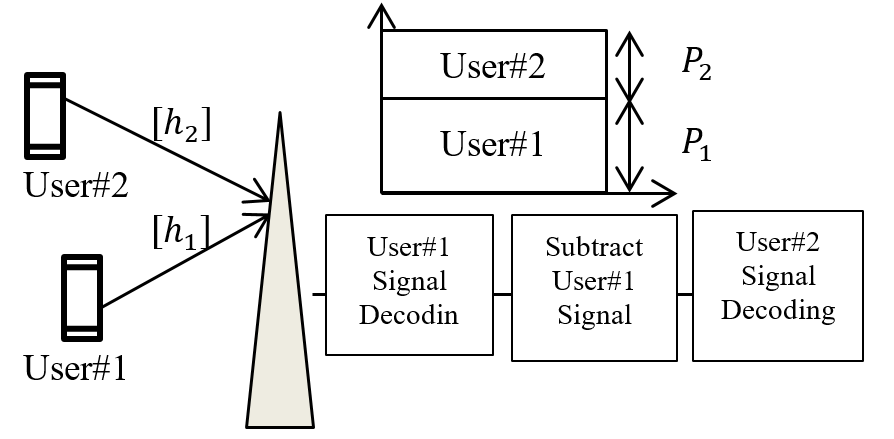 | Figure 1. Uplink Non-Orthogonal multiple access |
 | (1) |
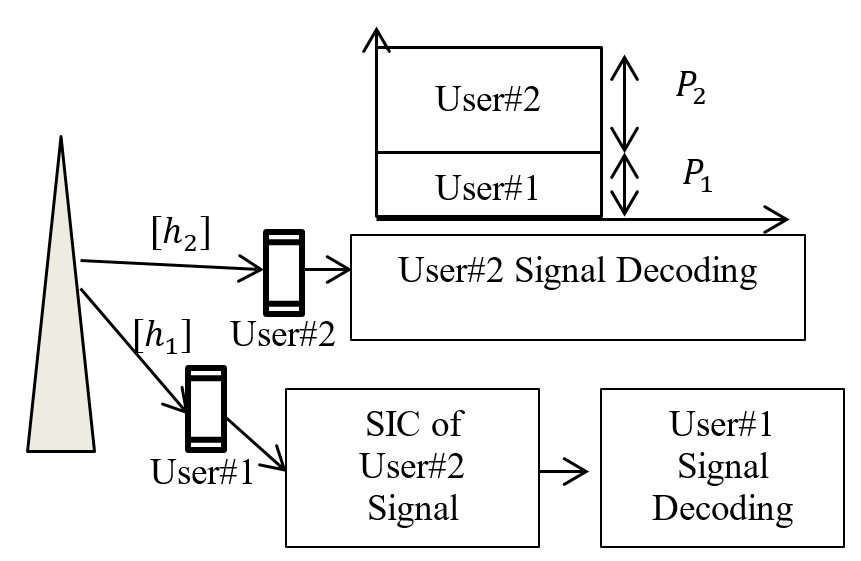 | Figure 2. Downlink Non-Orthogonal multiple access |
 indicates transmission power,
indicates transmission power,  denotes channel condition between User#1 and BS, and
denotes channel condition between User#1 and BS, and  indicates the transmitted message signal of User#1. On the other hand, for User#2
indicates the transmitted message signal of User#1. On the other hand, for User#2  indicates the transmitted power.
indicates the transmitted power.  denotes the channel condition between User#2 and BS and
denotes the channel condition between User#2 and BS and  is the signal of User#2 message. The term
is the signal of User#2 message. The term  represents Additive White Gaussian Noise (AWGN) in addition to inter-cell interference with spectral density
represents Additive White Gaussian Noise (AWGN) in addition to inter-cell interference with spectral density  [30]. Figure 2 depicts downlink NOMA system, suppose two users (i.e. User#1 is the near user with good channel condition and User#2 is the far user with bad channel condition), one sub-channel and
[30]. Figure 2 depicts downlink NOMA system, suppose two users (i.e. User#1 is the near user with good channel condition and User#2 is the far user with bad channel condition), one sub-channel and  which indicates channel coefficient of User#2 as the weak user and
which indicates channel coefficient of User#2 as the weak user and  implies channel coefficient of User#1 as the strong user. Assuming User#1 channel condition is better than User#2 which express as
implies channel coefficient of User#1 as the strong user. Assuming User#1 channel condition is better than User#2 which express as  . SIC technique is applied to User#1 which is assigned a low power level to decode User#2 signal and then remove it to be able to decode its signal at the end [31]. On the other hand, there does not need to perform SIC technique on User#2 because it assigned a high power level and only need to decode User#2 signal through treating User#1 signal as interference. The transmitted signal
. SIC technique is applied to User#1 which is assigned a low power level to decode User#2 signal and then remove it to be able to decode its signal at the end [31]. On the other hand, there does not need to perform SIC technique on User#2 because it assigned a high power level and only need to decode User#2 signal through treating User#1 signal as interference. The transmitted signal  for User#1 and
for User#1 and  for User#2 and power allocation
for User#2 and power allocation  and
and  given as
given as  . Transmitted superimposed signal by BS is expressed as:
. Transmitted superimposed signal by BS is expressed as: | (2) |
 is expressed as:
is expressed as:  | (3) |
 | (4) |
 | (5) |
 represents as the data rate of User#1 and
represents as the data rate of User#1 and  indicates as the data rates of User#2 and the total bandwidth of channel is
indicates as the data rates of User#2 and the total bandwidth of channel is  . Therefore, the summation of data rate of two users is the capacity of downlink NOMA represents as:
. Therefore, the summation of data rate of two users is the capacity of downlink NOMA represents as: | (6) |
 is divided by User#1 and User#2 in half. So the data rates are achieved by two individual users given as follows:
is divided by User#1 and User#2 in half. So the data rates are achieved by two individual users given as follows: | (7) |
 | (8) |
 represents as the data rate of User#1 and
represents as the data rate of User#1 and  indicates as the data rates of User#2 and total bandwidth of channel
indicates as the data rates of User#2 and total bandwidth of channel  is divided by two. Therefore, the summation of data rate of two users’ is the capacity of downlink OMA represents as:
is divided by two. Therefore, the summation of data rate of two users’ is the capacity of downlink OMA represents as: | (9) |
4. Downlink NOMA
- The BS transmits a message signal to User#1 and User#2 over the same sub-channel. In the NOMA system, the message signal of User#1 superimposed with User#2 signals multiplexed over a similar sub-channel. In general, the message signal of User#i (i is a multiple numbers of users) superimposed with other users’ signals multiplexed over a similar sub-channel. The BS transmits the superimposed signal to users using the same sub-channel. By using the SIC technique the receivers decode the originally transmitted signals iteratively where strong users (good channel condition users) demultiplex other signals to retrieve its signal in the end. On the other hand, the weak users (bad channel condition users) decode their signal directly treating other users’ signals as interference. SIC technique works based on different power allocations for individual users which are determined by the BS. In NOMA systems, the same type of message signal of two users is multiplexed over the same sub-channel shown in maximum research articles. Basically, the number of users who can share an individual sub-channel is not bounded to two users. It is possible to pair two or more users carefully by using superimpose system among a list of available users in the system. The basic condition to pair more than two users is a user with poor channel conditions (weak user) is chosen to be paired with a user with high channel conditions (strong user). The same types of message signals of user pairing are studied widely in different approaches proposed throughout a large number of researches. In this paper, different types of message signals for two users User#1 and User#2 pairing schemes are investigated to attain a clear understanding of the effect of different message signal pairing on the performance. The most straightforward approach is that message signals of pair users have selected the same type. It is simple yet inefficient to check the performance of NOMA when the different users send different types of message signals. In NOMA, the message signal of one user is superimposed on the other users’ message signal. Therefore, it’s decode system is more complex but in many approaches, the researchers show the better BER per performance against SNR when they have used same types of the transmitted signal [32]. In the OFDMA system, the individual user can send different types of messages as their requirement through an individual sub-channel. On the other hand, the NOMA decode system will be more complex when the users multiplex their different types of messages signal. In this paper, we have transmitted two different type’s message signals simultaneously to the two different users called User#1 and User#2. The image message signal is used for User#1 and the synthetic message signal is used for User#2. Firstly, two different data of users have multiplexed. Secondly, decode the two different data successfully in the receiving end and finally plot BER against SNR. From our simulation results, we have shown that the NOMA also gives better performance when the multiple users send multiple types of message signals concurrently.
5. System Model
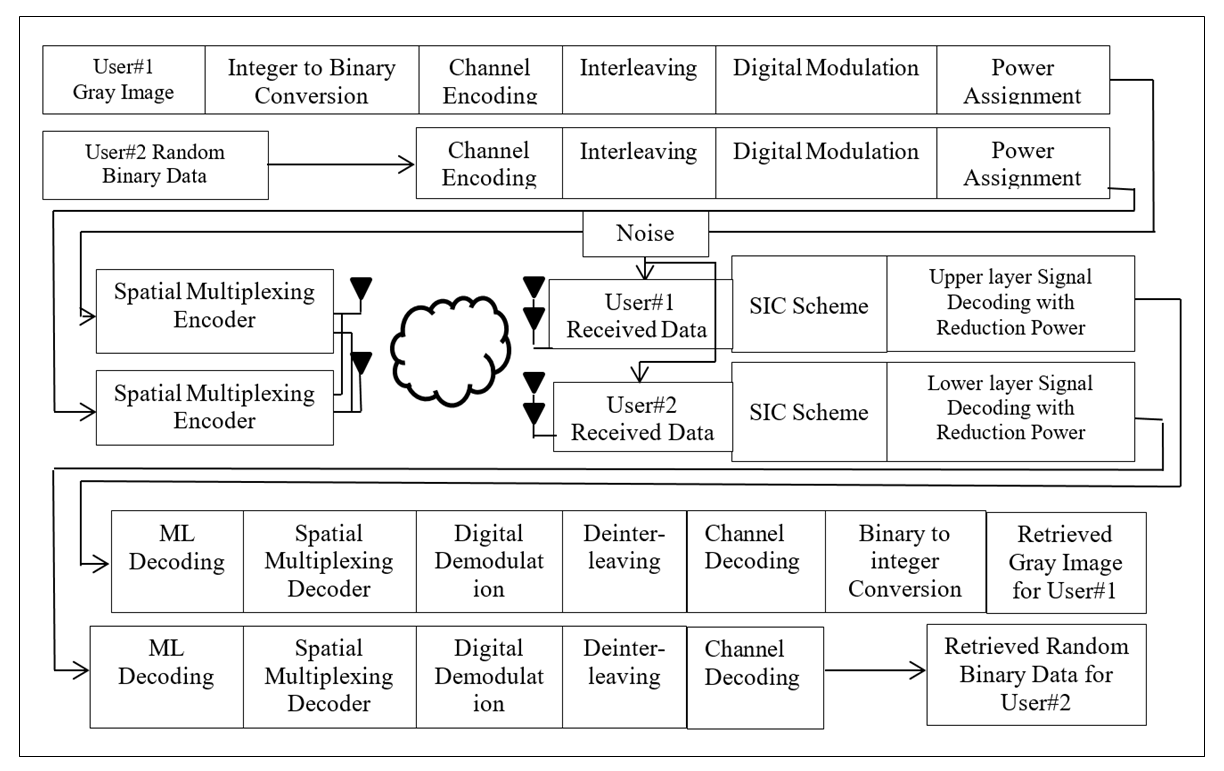 | Figure 3. Block diagram of MIMO NOMA wireless communication system |
6. Result and Discussion
- The system performance evaluation of multiuser with different data types downlink MIMO NOMA wireless communication is shown in this section. Our simulation results have been presented using MATLAB R2014a to clarify the significant change of various types of channel coding and digital modulation techniques on system performance in terms of bit error rate (BER). In the whole processing work, it is considered that at the receiver end the channel state information (CSI) of the fading channel is available with unchanged fading. Which parameters are used in our system to evaluate the system performance are shown in Table 1.
|
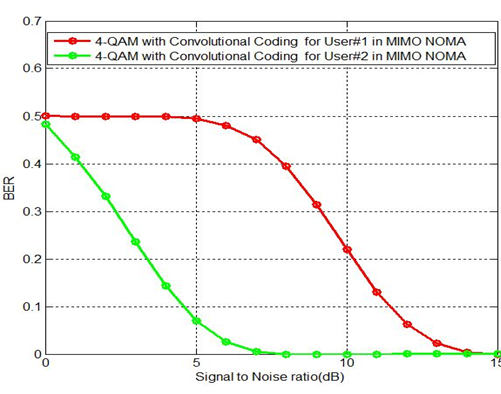 | Figure 4. BER performance of Convolutional channel encoded MIMO NOMA communication system with 4-QAM digital modulation scheme for image and binary data transmission |
 | Figure 5. Transmitted image of User#1 over AWGN channel with the 4-QAM modulation scheme |
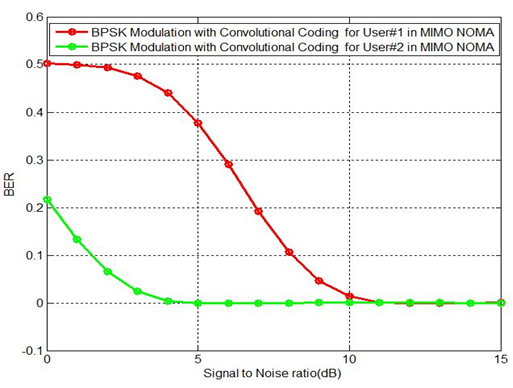 | Figure 6. BER performance of Convolutional channel encoded MIMO NOMA wireless communication system with BPSK digital modulation scheme for image and data transmission |
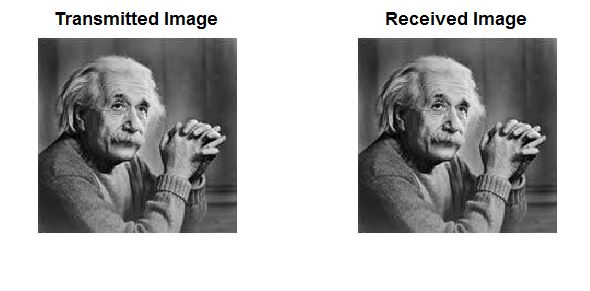 | Figure 7. Transmitted image of User#1 over AWGN channel with the BPSK modulation scheme |
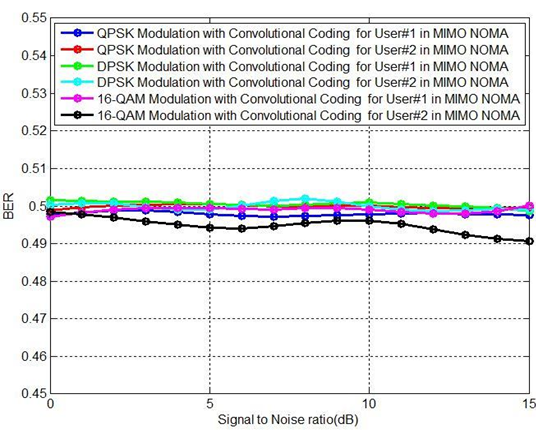 | Figure 8. BER performance of Convolutional channel encoded MIMO NOMA system with 16-QAM, DPSK, and QPSK digital modulation scheme for image and data transmission |
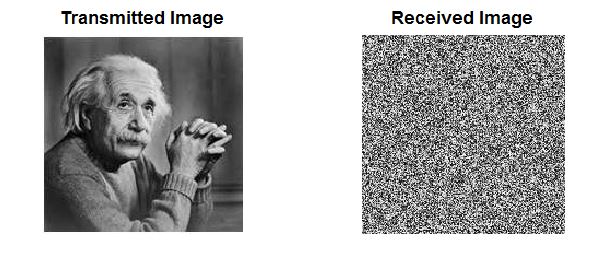 | Figure 9. Transmitted image of User#1 over AWGN channel with 16-QAM, DPSK, and QPSK modulation schemes |
7. Conclusions
- In this paper, a comprehensive study has been undertaken on the performance evaluation of the MIMO NOMA wireless communication system for the transmission of different types of data to different users simultaneously. The simulation results of the proposed system confirm that it is possible to transmit different types of data for different users in the MIMO-NOMA wireless communication system which meets one of the major requirements of the next generation wireless communication system like B5G/ 6G. It is also noticeable from the simulation results that the BER performances are very much robust and satisfactory with BPSK and 4-QAM modulation techniques and conventional channel coding schemes. The simulation results of the proposed system also represent that power allocation among the users affect significantly the performance of the system, far user deserves more power than the near user for implementing NOMA. In the context of system performance, it can be concluded that NOMA is suitable for simultaneously different data transmission over the AWGN channel in a hostile fading environment.
 Abstract
Abstract Reference
Reference Full-Text PDF
Full-Text PDF Full-text HTML
Full-text HTML